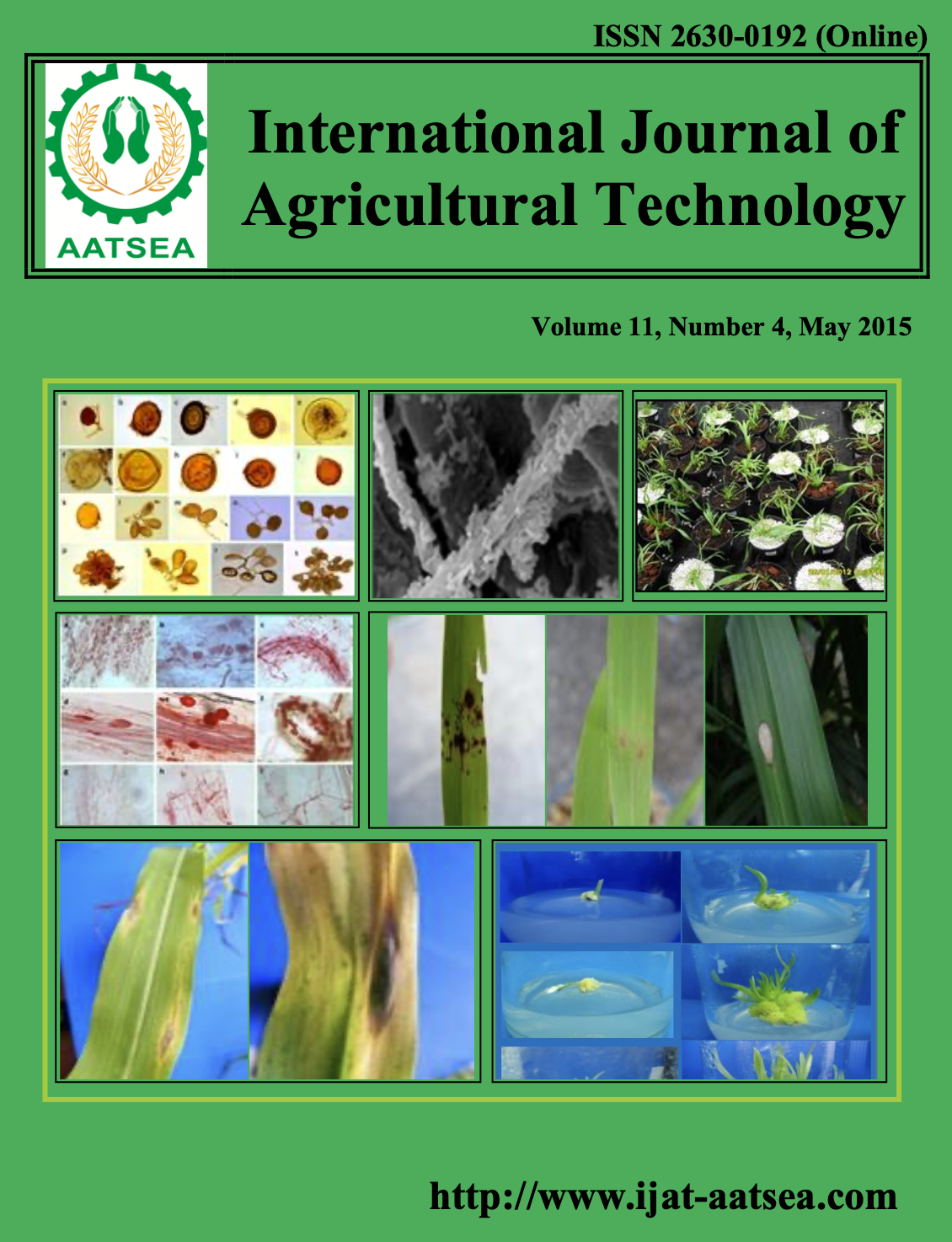Isolation and screening for inhibitory activity on Alternaria brassicicola of endophytic actinomycetes from Centella asiatica (L.) Urban
Main Article Content
Abstract
Article Details

This work is licensed under a Creative Commons Attribution-NonCommercial-NoDerivatives 4.0 International License.
References
Dochhil, H., Dkhar, M. S. and Barman, D. (2013). Seed germination enhancing activity of endophytic Streptomyces isolated from indigenous etho-medicinal plant Centella asiatica. International Journal of Pharma and Bio Sciences 4:256-262.
Getha, K. and Vikineswary, S. (2002). Antagonistic effects of Streptomyces violaceusniger strain G10 on Fusarium oxysporum f. sp. cubense race 4: indirect evidence for the role of antibiosis in the antagonistic process. Journal Industrial Microbiology Biotechnology 28:303-310.
Igarashi, Y., Iida, T., Sasaki, T., Saito, N., Yoshida, R., and Fujita, T. (2002). Isolation of actinomycetes from live plants and evaluation of antiphytopathogenic activity of their metabolites. Actinomycetologica 16:9-13.
Jamil, S. S., Nizami, Q. and Salan, M. (2007). Centella asiatica (Linn) Urban: Review Article. Natural Product Radiance 6:158-170.
Kenkyojo, S. (1987). New Dictionary of Color Name. Nihon Color Research Institute, Tokyo. 148 p. (in Japanese)
Kunasakdakul, K. and Suwitchayanon, P. (2012). Antimicrobial activities of chili and black pepper extracts on pathogens of Chinese kale. Chiang Mai University Journal of Natural Sciences 11:135-142.
Loria, R., Bukhalid, R. A., Fry, B. A. and King, R. R. (1997). Plant pathogenecity in the genus Streptomyces. Plant Disease 81: 836-846.
Prapagdee, B., Kuekulvong, C. and Mongkolsuk, S. (2008). Antifungal potential of extracellular metabolites produced by Streptomyces hygroscopicus against phytopathogenic fungi. International Journal of Biological Sciences 4:330-337.
Pridham, T. G., Hesseltine, C. W. and Benedict, R. G. (1958). A guide for the classification of Streptomycetes according to selected groups: Placement of strains in morphological sections. Antibiotics Annual 6:52- 79.
Qin, S., Xing, K., Jiang, J. H., Xu, L. H. and Li, W. J. (2010). Biodiversity, bioactive natural products and biotechnological potential of plant-associated endophytic actinobacteria. Applied Microbiology and Biotechnology 89:457-473.
Rakotoniriana, E. F., Rafamantanana, M., Randriamampionona, D., Rabemanantsoa, C., Ratsimamanga, S. U., Jaziri, M. E., Munaut, F., Corbisier, A. M., Leclercq, J. Q. and Declerck, S. (2013). Study in vitro of the impact of endophytic bacteria isolated from Centella asiatica on the disease incidence caused by the hemibiotrophic Fungus Colletotrichum higginsianum. Antonie van Leeuwenhoek 103:121-133.
Shimizu, M., Nakagawa, Y., Sato, Y., Furumai, T., Igarashi, Y., Onaka, H., Yoshida, R. and Kunoh, H. (2000). Studies on endophytic actinomycetes (I) Streptomyces sp. isolated from rhododendron and its antifungal activity. Journal of General Plant Pathology 66:360-366.
Shimizu, M. (2011). Endophytic actinomycetes: biocontrol agents and growth promoters. pp. 201-220. In D.K. Maheshwari (ed.) Bacteria in Agrobiology: Plant Growth Responses. Springer Heidelberg, London.
Shirling, E. B. and Gottlieb, D. (1966). Methods for characterization of Streptomycetes species. International Journal of Systematic and Evolutionary Microbiology 16: 313-340.
Takahashi, Y. and Omura, S. (2003) Isolation of new actinomycete strains for the screening of new bioactive compounds. Journal of General and Applied Microbiology 49:141154.


